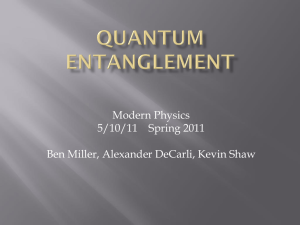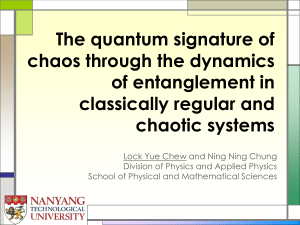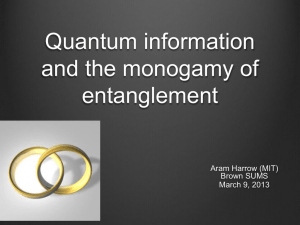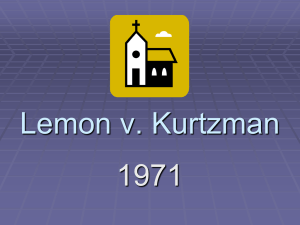Entanglement and Probability
advertisement
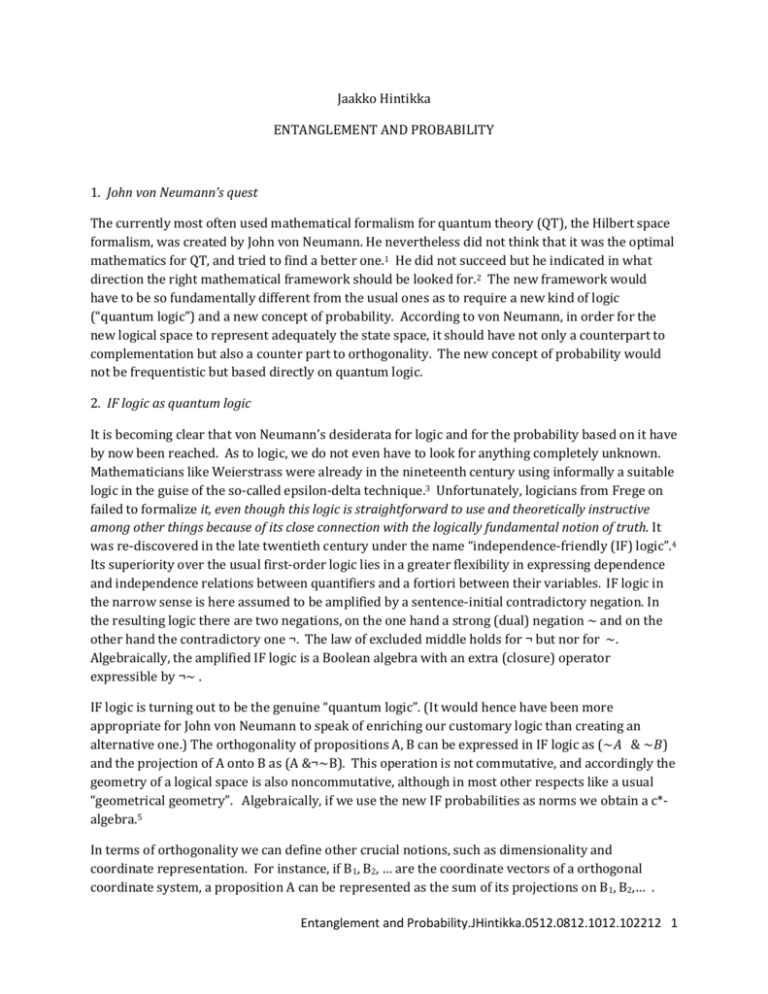
Jaakko Hintikka ENTANGLEMENT AND PROBABILITY 1. John von Neumann’s quest The currently most often used mathematical formalism for quantum theory (QT), the Hilbert space formalism, was created by John von Neumann. He nevertheless did not think that it was the optimal mathematics for QT, and tried to find a better one.1 He did not succeed but he indicated in what direction the right mathematical framework should be looked for.2 The new framework would have to be so fundamentally different from the usual ones as to require a new kind of logic (“quantum logic”) and a new concept of probability. According to von Neumann, in order for the new logical space to represent adequately the state space, it should have not only a counterpart to complementation but also a counter part to orthogonality. The new concept of probability would not be frequentistic but based directly on quantum logic. 2. IF logic as quantum logic It is becoming clear that von Neumann’s desiderata for logic and for the probability based on it have by now been reached. As to logic, we do not even have to look for anything completely unknown. Mathematicians like Weierstrass were already in the nineteenth century using informally a suitable logic in the guise of the so-called epsilon-delta technique.3 Unfortunately, logicians from Frege on failed to formalize it, even though this logic is straightforward to use and theoretically instructive among other things because of its close connection with the logically fundamental notion of truth. It was re-discovered in the late twentieth century under the name “independence-friendly (IF) logic”.4 Its superiority over the usual first-order logic lies in a greater flexibility in expressing dependence and independence relations between quantifiers and a fortiori between their variables. IF logic in the narrow sense is here assumed to be amplified by a sentence-initial contradictory negation. In the resulting logic there are two negations, on the one hand a strong (dual) negation ~ and on the other hand the contradictory one ¬. The law of excluded middle holds for ¬ but nor for ~. Algebraically, the amplified IF logic is a Boolean algebra with an extra (closure) operator expressible by ¬~ . IF logic is turning out to be the genuine “quantum logic”. (It would hence have been more appropriate for John von Neumann to speak of enriching our customary logic than creating an alternative one.) The orthogonality of propositions A, B can be expressed in IF logic as (~𝐴 & ~𝐵) and the projection of A onto B as (A &¬~B). This operation is not commutative, and accordingly the geometry of a logical space is also noncommutative, although in most other respects like a usual “geometrical geometry”. Algebraically, if we use the new IF probabilities as norms we obtain a c*algebra.5 In terms of orthogonality we can define other crucial notions, such as dimensionality and coordinate representation. For instance, if B1, B2, … are the coordinate vectors of a orthogonal coordinate system, a proposition A can be represented as the sum of its projections on B1, B2,… . Entanglement and Probability.JHintikka.0512.0812.1012.102212 1 (2) (𝐴 & ¬~B1) ∨ (𝐴 & ¬~B2) ∨ … = A & (¬∼ 𝐵1 ∨ ¬∼ 𝐵2 ∨ … ) = A & ¬(∼ 𝐵1 & ∼ 𝐵2 & …) = A 3. IF probability A few years ago it was shown by Sandu and Hintikka that IF logic comes with a natural concept of probability.6 It is definable in terms of the same semantical games as can be used as a semantics of IF logic in the first place. Semantical games are zero-sum two-person games. If mixed strategies are allowed, they have an equilibrium point in terms of which a probability distribution on the propositions of an IF language can be defined. This new concept of probability gives rise to a new probability calculus. As long as only the contradictory negation ¬ is involved, we have the usual laws. For the strong negation ∼, we obtain somewhat different laws. Since the law of excluded middle does not hold for ~, we do not always have (3.1) P(A ∨∼ 𝐴) = 1 (3.2) P(A) = P(A & B) + P(A & ∼ 𝐵) The logical behavior of the IF probability can be taken to reflect certain at first strange looking quantum-theoretical phenomena.7 For instance, two photon can pass a two-slit screen to a point behind it only through one slit (A) or the other, (B). Suppose we have detectors at each of the three locations. Then there are three distinguishable possibilities: “(1) the detectors at A and D go off, (2) the detectors at B and D go off, and (3) the detectors at D goes off alone.” (Feynman 1985, p. 82). What quantum theory tells us to do is to follow a principle according to which “the probability of each of the different possible fixed conditions is independently calculated….after that the several probabilities are added together in the normal fashion (Feynman 1988, p. 83) But here the first term cannot be #O, as is required by experiments. It can be if ¬ is reduced. in the old probability calculus this would be represented as (3.3) P(D&¬A & ¬B) + P(D & A & P(D & B) =1 A simple result of great theoretical interest is that Bell’s inequality fails in IF-logic based probability calculus. As one can see from any of its careful proofs, it depends essentially on equations like (3.2) that are not valid in IF-probability calculus (for the strong negation ~). From the asymmetry of the projection operator it follows that it is noncommutative: Entanglement and Probability.JHintikka.0512.0812.1012.102212 2 (3.4) ((A & (¬∼ 𝐵)) & ¬∼ 𝐴) = (A & ¬∼ 𝐵) is different from (3.5) (B & ¬∼ 𝐴) Their difference is (3.6) (¬𝐴 &¬~𝐴) ∨ (¬𝐵 & ¬~𝐵) Here A and B are results of measurement of complementary variables that depend on each other. Hence A has a determinate value, in other words, (A ∨ ~ A) is true, just in case B ab. has. If so the probability of (3.6) is a fixed constant, just as in Heisenbergian noncommutating relation. This relation thus shows up already on the level of quantum logic. Is there a calculus related to the concepts of truth and falsity? Game-theoretical semantics provides an interesting answer. In it, each proposition is associated with an imaginary two-person game G(S). One of the two players, “the verifier”, is trying to demonstrate the truth of S against the counterstrategies of “the falsifier”. Technically, this “demonstration” means we have the game end up with a true atomic sentence. Truth equals, not the verifier’s winning a play, but the existence of a winning strategy for the verifier. This existence is an objective (combinatorial) property of the model (“world”) on which G(S) is played. The falsity of S means that the falsier has a winning strategy. Since such semantical games are all determinate, it may happen that neither player has a winning strategy. Thus S is neither true nor false. In IF logic, the truth of S can thus be expressed simply by S (strictly, by ¬¬S),its falsity by ~S, and its being neither true nor false by (¬S & ¬~S). If it is assumed that both players use an optimal strategy against the (mixed) strategy one’s opponent has chosen, then their mutually balancing strategies serve to define the probability that S is true. Thus we can have = instead of ≥ in (4.2) only if it can always establish experimentally whether A. No wonder that Bell’s inequality, which relies on (4.2) fails when applied to quantum phenomenon. What is crucial here is that in the same way the truth of S is defined by reference to the semantical game G(S) that can be humanly playable, and yet is completely objective and independent of any particular play of the game, in the same way the probability P(S) of S in a given model is completely objective and independent of all particular plays of G(S). Entanglement and Probability.JHintikka.0512.0812.1012.102212 3 An interesting philosophical and methodological consequence is that this game-theoretical interpretation of the logic of experiments shows that it is possible to ascribe probabilities to systems completely objectively, as definable attributes of the system quite independently of whether the actual experimentation has been carried out and independently of experiential set or other circumstances. 5. On the logic of experiments This is all very simple, but it has a deeper interest in that it provides a conceptual model for experiments with possibly inconclusive outcomes. Such an experiment (experimental question) is like a play of the semantical game G(S) with a definite strategy. If the strategy is a winning one, the verifier wins. But winning does not show that S is true. Even if the verifier uses the same strategy in another play, depending on the falsifier’s strategy, the verifier may still lose. The part of the new probability logic that involves the strong (“orthrognalty”) negation ~ merely reflects these characteristics of the general nature of experimental questions. In quantum theory, the relevant experiments are often measurements. There often our gametheoretical semantics shows the conceptual possibility and complete objectivity of measurements with probabilistic outcomes. A measurement may be physically possible yielding a precise value for the variable that is being measured. Yet in a different sense such a measurement does not produce a definite value for the variable, but different values on different occasions. But the probabilities of these measurement values are definite, characteristic of the state of the system. These probabilities are completely objective, dependent only on the state of the system, not on the experimental setup or measuring instrument. This suggests an interpretation of Heisenbergian uncertainty relations. What is at issue is not any physical impossibility of measuring the values of two noncommuting variables at the same time, but the fact that both of these measurements cannot be non-probabilistic and that the probabilistic limits of “accuracy” are interdependent. On the propositional level, an accurate simultaneous measurement would correspond to the truth of (~¬A & ~¬B) which would mean geometrically not only the exclusiveness of ¬A and ¬B but their orthogonality. This orthogonality is a possible, fully objective state of the system. At the same time, in the same way as a play of a semantical game G(S) typically results in a definite win for one of the players, without thereby showing whether S is true or false, in the same way a quantum-theoretical variable may be measurable in the sense that an application of the measurement procedure produces a definite outcome. This is perfectly compatible with the fact that the registered value is obtained with a certain objective probability, dependent only on the state of the measured system. What is crucial here is that, in the same way as the truth of S, truth is defined by reference to a semantical game G(S) that can be humanly playable, and yet is completely objective and independent of any particular play of the game; in the same way the probability P(S) of S in a given model is completely objective and independent of all particular plays of G(S). Entanglement and Probability.JHintikka.0512.0812.1012.102212 4 4. On the logic of experiments But how is this new probability concept (“IF probability”) connected with experimental inquiry? If an experimental question concerns the state of a quantum-theoretical system, there is an obvious meaning to the inequalities that replace (3.1) and (3.2), viz (4.1) P(𝐴 ∨∼ 𝐴) ≤ 1 (4.2) P(𝐴) ≥ 𝑃(𝐴 & 𝐵) + 𝑃(𝐴 & ∼ 𝐵) What they bring out is that a system can in a sense have three different states. It can be in the definite state of A. Then a measurement (that is, an experimental question) yields the definite result A, and correspondingly for ~A. But if it is in neither state, a suitable experimental question (measurement) will still prompt an answer, but only with a fixed probability. This third state is characterized by this new IF probability. Thus a definitely positive answer to an experimental question can be codified as A (or strictly speaking, ¬¬A), a definitely negative answer as ∼A and a random answer as (¬A & ¬∼A). On the interpretation sketched here, IF logic is thus the logic of experiments. More generally speaking, in interpretational terms, an experiment concerning the truth of a proposition A can be thought of in terms of the semantical game G(A) against nature.8 A scientist and nature choose their strategies independently of each other. If the scientist has a strategy which leads to a definite answer “yes”, no matter what nature does. If nature has such a winning strategy, A is definitely false. If the game is indeterminate, a yes-no answer will come, but only with a certain probability assuming optimal choices of (mixed) strategies by the players. 5. IF logic and constituents The logical behavior of IF probabilities and their uses can be illustrated by a glimpse of how their numerical values can be determined. An actual assignment of probabilities in IF logic reduces to the assignment of probabilities the propositions called constituents.9 They are essentially orthogonal coordinate vectors in logical space. Any finite proposition in an IF language in a disjunction of a finite number of constituents. Constituents are mutually incompatible. A constituent is a list of all the different kinds of ramified sequences of elements one can draw from a model (structure, “possible world”) in which it is true. It has the form of a multiple tree structure. Can one see from such a formal constituent (tree structure) whether or not it could be true? In some cases, one can see that it cannot. All the elements corresponding to the nodes of the tree must come from the same domain (of the given model). Hence all the subtrees of the constituent must Entanglement and Probability.JHintikka.0512.0812.1012.102212 5 agree as closely as they can given the limitations of the comparison especially different lengths of the branches. But some constituents that are internally consistent in this sense can yet fail to be satisfiable. Such constituents are neither definitely true nor definitely false, and the source of the indefiniteness of other indefinite propositions. In the semantical game connected with a constituent a player’s pure strategy tells which branch to follow at each node. (Same notion of strategy for both players.) A play of the game hence follows a branch of the tree. A player’s mixed strategy assigns a probability to each branch emerging from each node. An a priori probability is obtained by assigning these probabilities on the basis of the number of branches diverging at a node. An a priori probability is obtained by assigning these probabilities on the basis of the number of branches diverging at a node, thus fulfilling von Neumann’s requirement that a priori quantum probabilities are logical. By weighting the branches differently we obtain other probability assignments. Defining IF probabilities for constituents suffices to define them for all propositions of an IF quantificational language in purely logical terms, as von Neumann envisaged. As he also pointed out, we can along the same lines define a logic-based concept of entropy. 10 6. Probabilities and states of a system These simple differences between the ordinary probability calculus and IF probability calculus may look small, but they suffice to explain the phenomenon of entanglement. We do not propose to define entanglement. It suffices to consider selected cases in order to come to understand what is going on. Let us consider what happens when a beam of quantum-theoretical particles is split into two according to whether they exhibit a certain characteristic property A or not. One of the simplest cases is splitting a beam of electrons into two according to whether their spin is “up” or “down”. Another would be to separate photons according to their polarization. To have a simple example, one may think of the relevant probabilities to be ½ . In such a case, it might at first seem that the two diverging beams consist of different kinds of electrons. No nontrivial correlation between what the electrons in one subbeam do with the other sub-beam is possible. However, in terms of IF probability the two beams are neither uniform nor without features in common. For instance, one half 50% the “up” beam consists of those electrons that are definitely “up” and 50% of indefinite electrons that are in the indefinite state but happen to exhibit the “up” option. The latter electrons may “look like” the former, because they have “chosen” the “up” option. But they are different in that they still have a possibility and an a priori ability of choosing “down” instead of “up”. Entanglement and Probability.JHintikka.0512.0812.1012.102212 6 Hence if the two beams are brought together again, we have the same probability mixture as in the original unsplit beam. But if one beam is stopped, no matter when, half of the other beam (with half intensity) consists of one half of electrons definitely up and other half of electrons whose spin can be up or down. If this half-beam is split, ¼ of the electrons select the “down” spin. This explains typical delayed choice phenomena.11 A recognition of the simple facts of IF probability is enough to understand what happens. What is suggested in this paper is that the same goes for all characteristically entanglement phenomena as is illustrated by John Bell’s insight that the quantum-theoretical phenomena as well as quantum theory itself seem to contradict the usual laws of probability.12 Indeed, Bell’s inequality is easily seen to fail in IF probability calculus because its derivation depends on laws like (3.1) and (3.2). Arguably the most puzzling aspect of entanglement is that it seems to involve nonlocality. In order to provide an adequate account of entanglement we therefore must explain how prima facie nonlocal phenomena can be accounted for with the help of IF probabilities. Delayed choice could already be seen as a case in point. As another test case as is illustrated by John Bell’s insight that the quantum-theoretical phenomena as well as quantum theory itself seem to contradict the usual laws of probability.12 Indeed, Bell’s inequality is easily seen to fail in IF probability calculus because its derivation depends on laws like (3.1) and (3.2) This explains delayed choice phenomena.11 A recognition of the simple facts of IF probability is enough to understand what happens. What is suggested in this paper is that the same goes for all characteristically entanglement of phenomena as is illustrated by John Bell’s insight that the quantum-theoretical phenomena as well as quantum theory itself seem to contradict the usual laws of probability.12 7. Entanglement and locality Arguably the most puzzling aspect of entanglement is that it seems to involve nonlocality. In order to provide an adequate account of entanglement we therefore must explain how prima facie nonlocal phenomena can be accounted for with the help of IF probabilities. Delayed choice could already be seen as a case in point. As another test case, we can take a BohmBell type experiment which can be summed up in the following diagram: Entanglement and Probability.JHintikka.0512.0812.1012.102212 7 (7.1) UP A Θ1 DOWN UP B UP Θ2 DOWN DOWN Here a beam of electrons is split into two semibeams according to whether or not they exhibit “up” or “down” behavior. The probability of each choice can be assumed to be ½ . Each semibeam then is deflected by a detector at A or B, respectively. These detectors are at an angle Ѳ1 or Ѳ2, respectively, from the incoming beam. The probability that an electron emerging from A is in “up” state depends on whether it entered in an “up” or “down” state and on the angle Ѳ1. This probability will be expressed by u(u, Ѳ1) or u(d, Ѳ1). Likewise we have the probabilities u(u, Ѳ2) and u(d, Ѳ2), etc. They are connected in an obvious way. An especially interesting variable here is the probability that there should be an agreement between the outcoming electrons in the upper and lower semi-branch. If we assume that each electron is in a definite “up” or “down” state, all electrons in the upper semi-beam are in the “up” state, and their probability of emerging with “up” state is therefore u(u, Ѳ1). Assuming locality, the probability of an “up” coincidence is therefore (7.2) 1 4 u(u, Ѳ1) ∙ u(d, Ѳ2) Hence if an “up” reading is recorded at A, the probability of a coincidence is u(d, Ѳ2). Entanglement and Probability.JHintikka.0512.0812.1012.102212 8 Alas, the formula (7.2) and its consequences do not agree with experimental evidence. This resulting theoretical situation is a paradigmatic instance of entanglement. An exception to (7.2) is also a challenge to locality, for if e.g. an “up” at A is assumed, according is given, the coincidence registered at B depends only on Ѳ2 but not on Ѳ1. A deviation from (7.2) hence seems to mean that changing the angle Ѳ1 at A affects what happens at B, even though A and B can be at a significant distance from each other. The consequences of (7.2) do not agree with experiments, however. These discrepancies are taken to exemplify the phenomenon of entanglement.14 This phenomenon calls for an explanation. If the conventional probability concept is assumed, an explanation is not easy to find. The most common kind of attempt is to give up locality in favor of some kind of “action at distance” or perhaps “passion at distance”. Such an idea is both theoretically and physically awkward to accept. In fact, (7.2) would be the last word here if the beam consisted only of electrons that are definitely in an “up” or in a “down” state. An electron in an indefinite state proceeds differently. It has to choose whether to go to A or to B, but it remains the same electron. Hence, it reacts in A and B in the same way. For this reason, some of observed coincidences are between two possible paths of one and the same electron. For such an electron u(u(⊝)) = u(d(⊝)) for any ⊝. Consequently, for indefinite state electrons u and d are not needed as arguments, and the “up” coincidence rate will be (7.3) 1 4 u(⊝1 ) ∙ u(⊝2 ) There the probability of a coincidence, given an “up” reading at A, is expressed no longer by 1 u(d,Ѳ2) but one half of (7.3) . This depends on Ѳ1 and not only on Ѳ2 accounting for the allegedly 2 mysterious correlation. The coincidence sets can be changed by changing Ѳ1 , which apparently violated locality. This explains the entanglement phenomenon in this experimental situation. The explanation does not turn on nonlocality. Rather, what happens is that one and the same particle can have a non-zero probability of being at different locations at a given time. Since a part of the electrons in the original beam are of this kind, i.e. are in an indefinite state, their “entanglement” manifests itself. The explanation does not turn on “hidden variables” in the usual sense, either. The only unobservable variable is an electron’s being in a definite state or an indefinite state. A similar explanation works in other cases of entanglement, again without nonlocality or hidden variables. This encourages ontological realism in the interpretation of quantum theory. 8. Entanglement disentangled These case studies show what is involved in the phenomena that are labeled “entanglement”. As the term presupposes, entanglement is a relationship between two or more quantum theoretical objects. They are entangled in so far as they can be considered as realizations of different alternative possibilities concerning one and the same object. They can be so considered insofar as Entanglement and Probability.JHintikka.0512.0812.1012.102212 9 their difference lies in the value of a variable with an indefinite value. Such a variable can be freed to assume a sharp value different for the different entangled objects, but the two must share all the definite values of their variables, including their presupposition to behave in one or another way in identical situations. These propensities are the only “hidden” variables we need. Mathematically this can be expressed in terms of IF probabilities. Two entangled systems (objects) we have are characterized by the same values of their variables, but these values can be probabilistic and not definite. Those probability values can manifest themselves as different measured values. Such values are what distinguishes entangled but different from one another. A full theory of entanglement remains to be worked out. Its theoretical implications are not discussed here, either, except for a couple of clarifying observations. The reliance on competing possibilities in the discussion above might seem reminiscent of the many-worlds interpretation of Everett and others. 5 In reality we are in a position to see a profound difference between the approach used here and many-worlds interpretations. Their leading idea in that probabilities in quantum theory are at bottom created by the branching of worlds. In contrast, one of the most characteristic features of probabilities in quantum theory are at bottom created by the branching of worlds. In contrast, one of the most characteristic of IF probabilities features is that they are probabilities of what can be and what can happen and does happen in the actual world. (Cf. here especially sec. 5 above.) In this respect, too, our IF seems to be the kind of probability notion that von Neumann was looking for. Entanglement and Probability.JHintikka.0512.0812.1012.102212 10 NOTES 1. Rédei and Stöltzner 2001 2. Von Neumann 2001(1954) 3. Hintikka, forthcoming 4. See e.g. Mann et al., 2011 and Hintikka 1996 5. Hintikka 2009 6. See Mann, et al., 2011 and Hintikka 2009 7. See e.g. Feynman 1985, pp. 77-84 8. See e.g. Hintikka and Sandu, 1996 9. See e.g. Hintikka 1965 10. Von Neumann 2001 (1954) 11. Wheeler 1983 12. Bell 1993 13. Cf. e.g. Clauser and Shimony 1997 14. Cf. e.g. Cohen et al., 1997 15, De Witt and Graham 1973; Saunders et al. 2010 Entanglement and Probability.JHintikka.0512.0812.1012.102212 11 References Bell, J. S.: Speakable and Unspeakable in Quantum Mechanics. Cambridge U.P., Cambridge (1993) Clauser, J.F., Shimony, A.: Bell’s theorem, experimental tests and implications. Reports on Progress in Physics 41, 1881-1927 (1978) Cohen, R. S., Horne, M., Stachel, J. (eds.): Potentiality, Entanglement and Passion-at-a-Distance, Kluwer, Dordrecht (1997) De Witt, B.S., Graham, N. (eds.): The Many-Worlds Interpretation of Quantum mechanics, Princeton U.P., Princeton (1973) Feynman, R.P.: QED: The Strange Theory of Light and Matter. Princeton U.P., Princeton. (1985) Fine, A.: The Shaky Game. Princeton U.P., Princeton (1987) Hintikka, J.: IF logic in a wider setting. In: Degremont, C., Keiff, L., Rueckert, H. (eds), Dialogues, Logics and Other Strange Things. 195-210. College Publications, London (2009) Hintikka, J.: Principles of Mathematics Revisited. Cambridge U.P., Cambridge (1996) Hintikka, J.: Distributive normal forms in first-order logic. In: Crossley, J.N., Dammett, M.A.E. (eds.): Formal Systems and Recursive Functions. 48-91. North-Holland, Amsterdam. (1965). Hintikka, J.: Which mathematical logic is the logic of mathematics? In Logica Universalis. forthcoming. Hintikka, J., Sandu, G.: Game-theoretical semantics. In: J. van Bentham and Alice ter Meulen, Handbook of Logic, Semantics and Language. Elsevier, Amsterdam (1996). Mann, A., Sandu, G., Sevenester, M.: Independence-Friendly Logic: A Game-Theoretical Approach. Cambridge, Cambridge (2011). Rédei, M., Stöltzner, M. (eds.): John von Neumann and the Foundations of Quantum Physics. Kluwer, Dordrecht (2001). Saunders, S., Barrett, J., Kent, A., Wallace, D. (eds) Many Worlds? Oxford U.P., Oxford. Von Neumann, J.: Unsolved problems in mathematics. In Rédei, M. and Stöltzner, M. (eds.): John von Neumann and the Foundations of Quantum Physics, pp. 231-245. Kluwer, Dodrecht (2001). Wheeler, J. A.: Law without law. In Wheeler, J.A. and Zurek, W.H. (eds.): Quantum Theory and Measurement, pp. . Princeton U.P., Princeton (1983). Wheeler, J. A., Zurek W.H. (eds.), Quantum Theory and Measurement. Princeton U.P. Princeton. (1983). Entanglement and Probability.JHintikka.0512.0812.1012.102212 12 SIX KEY WORDS probability entanglement, quantum logic, nonlocality, Bell’s inequality, IF logic Entanglement and Probability.JHintikka.0512.0812.1012.102212 13

